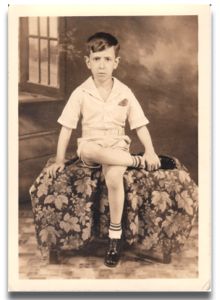War marriages were very much the stuff of Hollywood romance during World War II. The most shining example would likely be the 1945 MGM classic The Clock, starring Judy Garland and Robert Walker as a young woman and a soldier who meet and fall in love over the course of a few days and quickly rush to the alter (or in their specific case, a New York City Justice of the Peace.)
There was certainly a reality behind these whirlwind movie courtships, so much so that the War Department produced a pamphlet in 1944 urging soldiers to demonstrate caution and good judgment when considering any such hurried decisions involving near spontaneous matrimony. The 32-page booklet was entitled Can War Marriages Be Made to Work? and was classified as War Department Education Manual EM30. It was part of the G.I. Roundtable series, a series of pamphlets that were also designed to be the basis of potential discussion groups attended by servicemen.
The pamphlet quickly poses the question, "Why War Marriages?" The answer:
Many war marriages are hasty marriages. Many are made while men are on leave or furlough. Often the time of the marriage is determined by the approaching end of a short leave.
Military promptness and the speed-up of work in war plants tend to hasten marriage. Entrance into service is an abrupt change Of status. Why not, some argue, make an abrupt change from single to married status? If war can change life overnight, why not make the change more complete by marrying? If the Army is going to snatch you away from civilian life, why not strengthen your ties with that life by leaving a wife behind you? And for many a girl who watches the boys going away from the home town, the "dates" of the hectic hours before they go may seem the last chance for marriage.
Courtship, no matter how disguised, is competition. To the soldier marriage offers, among other advantages, a device to ward off the competition of rivals while he is away.
In war nothing is certain but uncertainty. Even an unwise marriage may give a feeling of certainty for a moment. Unconsciously it may seem to offer an escape from doubts and confusion.Though very much rooted in the culture of the 1940s, Can War Marriages Be Made to Work? provides some surprisingly progressive advice by way of its concept of the 50-50 marriage:
Many war marriages come about through loneliness or fear of loneliness. A soldier returns to his home town on leave; his old friends are gone; many things have changed. Or a girl takes a job away from home and is separated from her family and friends. Both to the girl away from home and to the soldier on leave, marriage is an intimate relationship that seems to offer escape from loneliness. Absence makes the heart grow fonder—if there is nobody else. And there may be nobody else in time to prevent a marriage that might never have taken place under normal conditions.
The "fifty-fifty" marriage, the kind in which neither husband nor wife orders the other around but in which they share equal authority and parallel responsibility, seems to have the best chance of success. There are persons who like to be bossed and others who enjoy bossing. If such individuals happen to pair off, the marriage may be a success. But in general American women are not by temperament or by training inclined to play the role of door mat in marriage any more than American men.
In fact, a couple's attitude toward equality in marriage relationship may be as important as the actual division of authority and responsibility between them. One recent study showed that husbands opposed to rights for women were somewhat less likely to be happily married than those more tolerant on the subject of equal rights and responsibilities for women. Many happily married couples assert that a "fifty-fifty" meeting is not enough—that each must be ready to go more than half way and provide, -in a "sixty-sixty" arrangement, a wide area for compromise.











0 comments:
Post a Comment